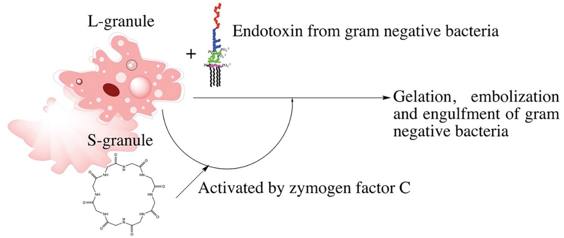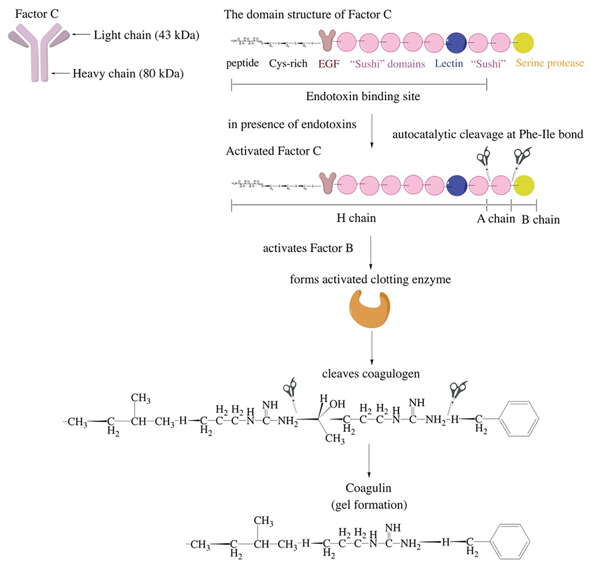LAL Assay
As a standard method for endotoxin detection of medical devices and parenteral drugs, the Limulus amoebocyte lysate (LAL) test includes three main types: gel-clot, chromogenic, turbidimetric Assay. Creative Biolabs provides LAL assay to detect the presence or absence of endotoxin in various test samples. Here we specifically focus on the method, key benefits of three subtypes of LAL Assay and outline the mechanism of LAL assay.
Background of LAL
In the 1950s, it is found that Limulus polyphemus, existing in the blood of horseshoe crabs, can form a clot when exposed to LPS. Later, this reaction was found that caused by a clotting factor contained in granules in motile blood cells called amoebocytes. Finally, this reaction has been developed into a test based on immunogenic reaction for endotoxin by harvesting amoebocytes from the blood of horseshoe crabs and then lysing the cells to produce a reagent containing the clotting factor - LAL.
 Fig.1 Endotoxin-induced defense mechanisms in circulating hemolymphs of horseshoe crabs. (Mason, 2019)
Fig.1 Endotoxin-induced defense mechanisms in circulating hemolymphs of horseshoe crabs. (Mason, 2019)
Mechanism of LAL Assay
LAL test relies on factor C coagulation cascade found in horseshoe crabs' blood. The combination of endotoxin and zymogen factor C initiates the protease cascade. Next, the activated factor C goes onto activate factor B, which converts the proclotting enzyme to the clotting enzyme. Lastly, two peptide bonds in coagulogen are catalytically cleaved to form coagulin gel.
 Fig.2 Coagulation cascade in horseshoe crab blood. (Mason, 2019)
Fig.2 Coagulation cascade in horseshoe crab blood. (Mason, 2019)
Main Methods of LAL Assay
The gel-clot LAL assay is a simple test that evaluates the presence of endotoxin in a given sample. It is a semi-quantitative method with sensitivity to 0.3 EU/mL. If the sample exists endotoxin, a gel-clot has formed which will not dislodge when the tube is inverted, the test shows positive. Otherwise, there will be liquid in the tube when inversion is attempted, which means no endotoxin is present or more likely a non-detectable amount is present, in either case, a negative test.
Advantages of this method are as follows:
-
Many samples can be processed at once
-
Inexpensive and easy to conduct
The chromogenic LAL assay is performed by a chromogenic or colored one. The chromogenic substrate is cleaved by an endotoxin-activated enzyme coagulase, and the chromogenic molecule is released from the substrate into the suspension measured by spectrophotometry. It has a sensitivity to 0.005 EU/mL. The sample is mixed with lysate and placed into a plate reader. If a yellow color appears over time, it indicates the presence of endotoxin.
Advantages of this method are as follows:
-
A better choice for the analysis of parenteral and vaccines
-
Less influence by inhibitory substances
The turbidimetric LAL method is similar to the chromogenic assay but instead measures the turbidity of the solution. It is a reliable and quantitative method with sensitivity to 0.001 EU/mL. In this assay, a pro-enzyme in the lysate is activated by the direct presence of endotoxin. Activation level can be quantified spectrophotometrically when the lysate/sample group becomes more turbid. The rates of absorbance and turbidity change are proportional to the endotoxin concentration. This assay is featured by its high sensitivity.
Creative Biolabs has been committed to the research and development of multiple detection methods of endotoxin for many years. As a world-famous service provider for endotoxin detection, we also provide a variety of LAL assay-related kits. To gain more detailed information, please feel free to contact us or directly send us an inquiry.
References
-
Su, W.; et al. Methods of endotoxin detection. Journal of Laboratory Automation. 2015, 20(4): 354-364.
-
Mason, S.; et al. Current technologies to endotoxin detection and removal for biopharmaceutical purification. Authorea. 2019.
-
Schultz, C. Endotoxin detection assays. Gen Int Med Clin Innov. 2018.
For Research Use Only | Not For Clinical Use


 Fig.1 Endotoxin-induced defense mechanisms in circulating hemolymphs of horseshoe crabs. (Mason, 2019)
Fig.1 Endotoxin-induced defense mechanisms in circulating hemolymphs of horseshoe crabs. (Mason, 2019)
 Fig.2 Coagulation cascade in horseshoe crab blood. (Mason, 2019)
Fig.2 Coagulation cascade in horseshoe crab blood. (Mason, 2019)
 Download our brochure
Download our brochure

